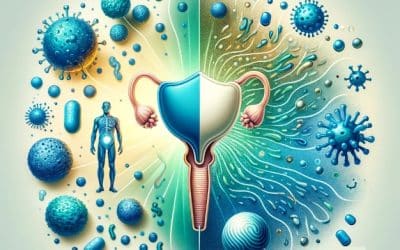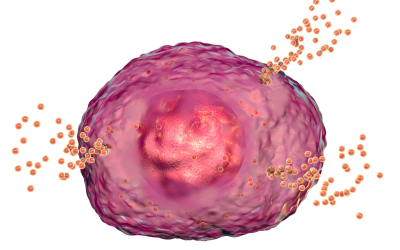Powerful Phytochemical Rich Foods that Fight Cancer
Cancer is recognized worldwide to be a major health problem in the modern world. Cancer is a systemic disease with various causes, some of which include a poor diet, toxin exposure, nutrient deficiencies and to some extent genetics. The management of cancer can be invasive and complex, and involves conventional approaches such as surgery, radiation and chemotherapy. Despite these modern advances, cancer continues to account for fourteen million new cases and roughly eight million deaths each year (Kotecha, Takami, & Espinoza, 2016). As a result, alternative methods may be needed to improve the effectiveness of the treatments and quality of life of patients.
The good news is that certain foods are cancer fighting and can both prevent and also help in the treatment of cancer therapy! That is because foods contain phytochemicals. I like to think of them as fight-chemicals, or chemicals that help you fight disease. Phytochemicals are naturally occurring plant chemicals that play important roles in health (Murphy, Barraj, Spungen, Herman, & Randolph, 2014). For example, beta-carotene (think carrots) and lycopene (think tomatoes) can reduce the risk of cardiovascular disease (CVD). Others such as lutein and zeaxanthin may reduce the effects of oxidative damage that is associated with age related macular degeneration. And ellagic acid found in raspberries may reduce oxidative damage to DNA (Murphy et al., 2014).
Over production of free radicals and inflammation are some of the contributing factors to the development of cancer. Naturally occurring phytochemicals have been found to have a wide range of cellular effects that may be chemo-protective in the early stages of cancer. Antioxidant phytochemicals can be found in many foods and medicinal plants, and they play an important role in the prevention and treatment of chronic diseases such as cancer (Zhang et al., 2015). They can also enhance the immune system, improve elimination of cancerous cells and impact your body’s repair mechanisms aimed at suppressing tumors and inhibiting cellular growth (Kotecha et al., 2016).
Foods that prevent cancer
1. Turmeric (Curcumin)-Turmeric contains curcumin which is a polyphenol that gives turmeric its golden color and distinct aroma. Curcumin’s effects against cancer have only emerged in the last few decades (Park, Amin, Chen, & Shin, 2013). Curcumin is classified as an anti-proliferative, antioxidant and carcinogen blocking agent (Park et al., 2013). In an attempt to increase its bioavailability, several curcumin formulations have been developed such as powder, tablets, capsules, liposomal encapsulation, emulsions, and nanoparticles (Shanmugam et al., 2015). Curcumin is an excellent synergist and works well in combination with other compounds such as quercetin, bioperine, piperine, lactoferrin, and soy isoflavones (Shanmugam et al., 2015). Adding turmeric and black pepper to your onions would be a great anti-cancer synergistic side dish.
2. Blueberries-consist of anthocyanins (ACNs), a water -soluble flavonoid and a member of the flavonoid family. Anthocyanins offer rich, robust, deep, dark, and beautiful colors like blues, purples, and reds in many fruits, flowers and leaves (Fang, 2014). Anthocyanins are known for their antioxidant protection. They are also known for their anti-viral, anti-inflammatory, and anti-cancer benefits. This is accomplished by increasing scavenger hunting capabilities in cells which subsequently stimulates the Phase II detoxification system. In vitro animal studies demonstrated a reduction in oxidative stress as measured in urine (urinary 8- OHdG levels), indicating that berries may also reduce free radical-induced DNA damage in animals (Wang &Stoner, 2008).
3. Tomatoes-Tomatoes are high in a phytochemical called lycopene, which is actually a carotenoid that gives tomatoes their beautiful red color. Lycopene is one of the strongest antioxidant in nature and has both free radical scavenging properties as well as the ability to provide balance within the cell’s internal defense system (Gajowik & Dobrzynska, 2014). Epidemiological studies have shown that high intake of lycopene-containing vegetables is inversely associated with the incidence of certain types of cancer, including cancer of the digestive tract, prostate and cervix. Interestingly, a combination of vitamin E, selenium and lycopene has been shown to dramatically inhibit prostate cancer development and the increase disease free survival (Scarpa & Ninfali, 2015). A meal with tomatoes, brazil nuts and avocados may be a great way to prevent prostate cancer. Lycopene has also been shown to inhibit cell proliferation and is able to induce programmed cell death of cancer cells (Kotecha et al., 2016). Tip: dietary fats can enhance lycopene absorption and metabolism. Go ahead and add some olive oil to your tomato sauce to enhance the cancer-fighting properties of lycopene.
4. Sweet potatoes- Sweet potatoes contain beta-carotene which gives them their nice orange color. The human body converts beta-carotene into vitamin A (retinol) making beta-carotene a precursor to vitamin A, which is an essential nutrient. Beta-carotene, like lycopene, exhibits anti-oxidant properties that can protect the body from free radicals, a primary cause of aging, degeneration and cancer. Beta-carotene has also been identified in the ability to inhibit the growth of cancer stem cells in neuroblastoma (Scarpa & Ninfali, 2015). The only caveat is taking beta-carotene if you are a smoker. Studies indicate that smokers can actually have an increased risk of cancer if supplemented with beta-carotene. (Virtamo et al., 2014). These findings indicate that if you smoke heavily you should consult with your health care provider before supplementing with beta-carotene.
Foods that can treat cancer
1. Aloe Vera– Aloe Vera is an amazing mixture of more than 200 constituents, including polysaccharides, enzymes, glycoproteins, amino acids, vitamins and minerals. Aloe Vera contains polysaccharides that has been associated with immune modulation (Foster, Hunter, & Samman, 2011). These polysaccharides have been shown to act as a bridge between foreign proteins and immune cells (macrophages) in the human body, facilitating the destruction of the foreigner by the macrophage. One polysaccharide in particular is called acemannan, which can interject itself into all cell membranes which can improve the metabolism of the cell. Also, acemannan is known to have antiviral and antitumor activities through activation of immune responses. Acemannan induces your macrophages to secrete three anti-cancer compounds: interferon, tumor necrosis factor-α, and interleukins. Other immune functions of acemannan include: reducing inflammation, improve macrophage function, enhance antibody release, increase T-cell production, and improve nutrient absorption through the GI-tract.
2. Green tea catechins-Green tea is a flavanol polyphenol that is really a fancy word for antioxidant compounds in the food. Of all the antioxidant compounds found in green tea, the major constituents are the polyphenols, including phenolic acids and catechins (Du et al., 2012). ECGC is the major catechin in green tea that is known for its robust antioxidant activity. In fact, effects of green tea on chemoprevention have been attributed to its antioxidant potential. They can act on inflammatory processes by altering the recruitment of inflammatory cells from the circulation (Tangney & Rasmussen, 2013). Polyphenols in green tea can improve oxidative stress markers. Green tea’s ECGC is thought to exert their anti-oxidant power by preventing specific DNA damage by free radicals and preventing tumor formation (Kotecha et al., 2016) Green tea polyphenols have been shown to directly inhibit tumor cell growth by inducing apoptosis (programmed cell death) through multiple pathways linked in cancer development.
Hippocrates once said, “let food be thy medicine, and medicine be thy food”. One of the best ways to prevent cancer is through the diet. Check out my recipes to find some cancer fighting recipes that you can enjoy!
References
Du, G. J., Zhang, Z., Wen, X. D., Yu, C., Calway, T., Yuan, C. S., & Wang, C. Z. (2012). Epigallocatechin Gallate (EGCG) is the most effective cancer chemopreventive polyphenol in green tea. Nutrients, 4(11), 1679-1691. doi:10.3390/nu4111679
Foster, M., Hunter, D., & Samman, S. (2011). Evaluation of the Nutritional and Metabolic Effects of Aloe vera. In nd, I. F. F. Benzie, & S. Wachtel-Galor (Eds.), Herbal Medicine: Biomolecular and Clinical Aspects. Boca Raton (FL): CRC Press/Taylor & Francis
Llc.
Gajowik, A., & Dobrzynska, M. M. (2014). Lycopene – antioxidant with radioprotective and anticancer properties. A review. Rocz Panstw Zakl Hig, 65(4), 263-271.
Kotecha, R., Takami, A., & Espinoza, J. L. (2016). Dietary phytochemicals and cancer chemoprevention: a review of the clinical evidence. Oncotarget, 7(32), 52517-52529. doi:10.18632/oncotarget.9593
Murphy, M. M., Barraj, L. M., Spungen, J. H., Herman, D. R., & Randolph, R. K. (2014). Global assessment of select phytonutrient intakes by level of fruit and vegetable consumption. Br J Nutr, 112(6), 1004-1018. doi:10.1017/s0007114514001937
Park, W., Amin, A. R., Chen, Z. G., & Shin, D. M. (2013). New perspectives of curcumin in cancer prevention. Cancer Prev Res (Phila), 6(5), 387-400. doi:10.1158/1940-6207.capr-12-0410
Scarpa, E. S., & Ninfali, P. (2015). Phytochemicals as Innovative Therapeutic Tools against Cancer Stem Cells. Int J Mol Sci, 16(7), 15727-15742. doi:10.3390/ijms160715727
Shanmugam, M. K., Rane, G., Kanchi, M. M., Arfuso, F., Chinnathambi, A., Zayed, M. E., . . . Sethi, G. (2015). The multifaceted role of curcumin in cancer prevention and treatment. Molecules, 20(2), 2728-2769. doi:10.3390/molecules20022728
Tangney, C. C., & Rasmussen, H. E. (2013). Polyphenols, inflammation, and cardiovascular disease. Curr Atheroscler Rep, 15(5), 324. doi:10.1007/s11883-013-0324-x
Virtamo, J., Taylor, P. R., Kontto, J., Mannisto, S., Utriainen, M., Weinstein, S. J., . . . Albanes, D. (2014). Effects of alpha-tocopherol and beta-carotene supplementation on cancer incidence and mortality: 18-year postintervention follow-up of the Alpha-tocopherol, Beta-carotene Cancer Prevention Study. Int J Cancer, 135(1), 178-185. doi:10.1002/ijc.28641
Zhang, Y. J., Gan, R. Y., Li, S., Zhou, Y., Li, A. N., Xu, D. P., & Li, H. B. (2015). Antioxidant Phytochemicals for the Prevention and Treatment of Chronic Diseases. Molecules, 20(12), 21138-21156. doi:10.3390/molecules201219753








